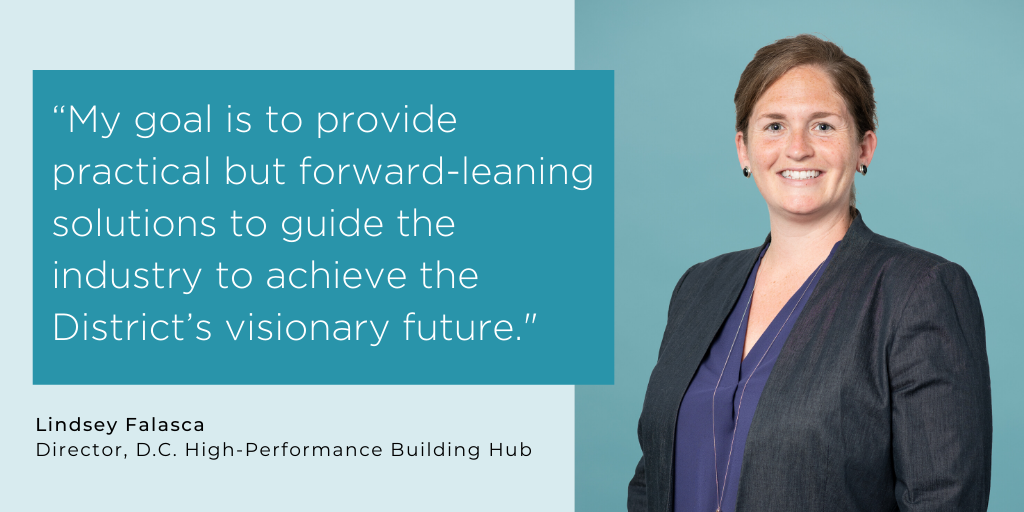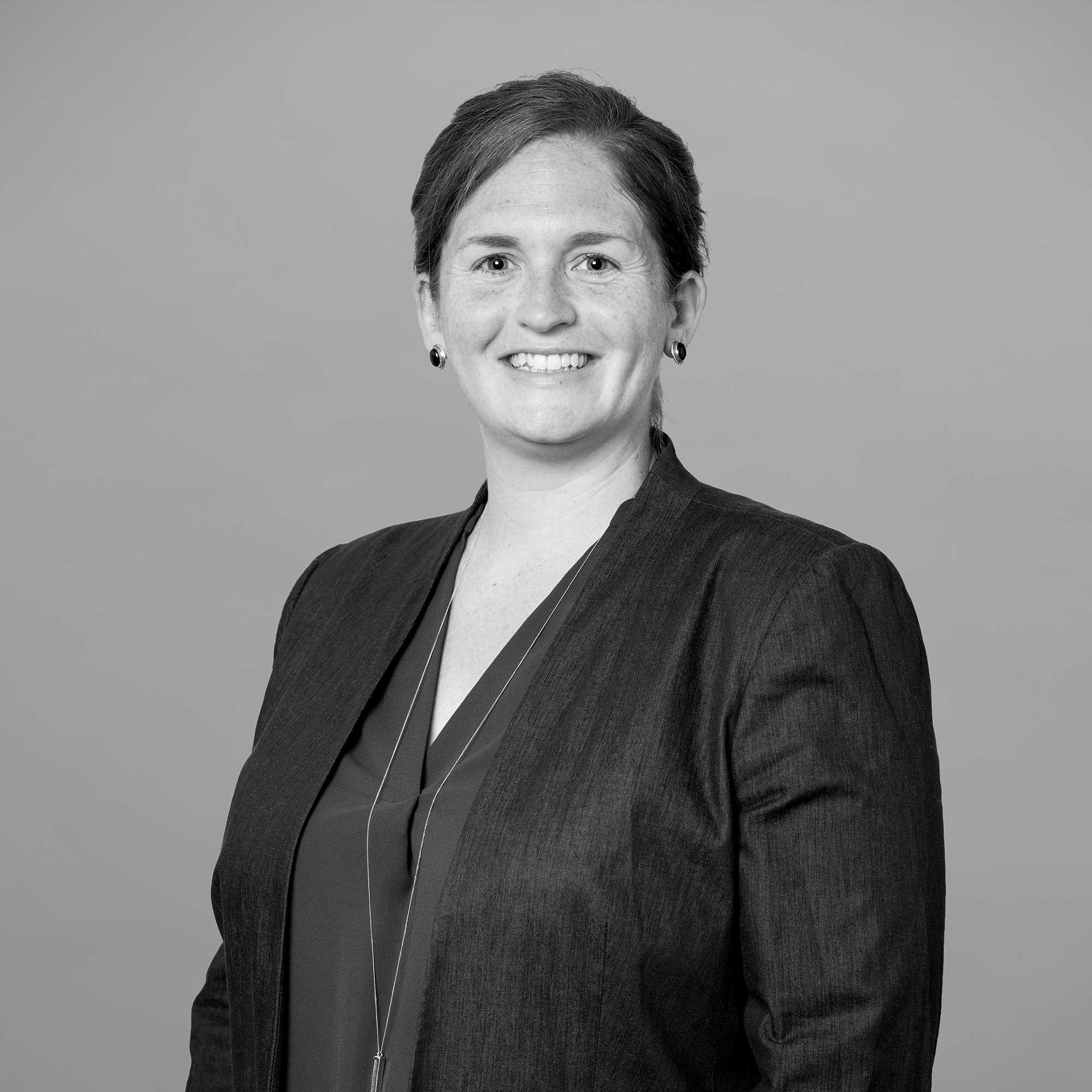Lindsey Falasca was recently announced Director of the District of Columbia’s newly created High-Performance Building Hub. The Hub is expected to play a significant role in helping the District reach it’s carbon reduction and climate goals. In this Q&A, Lindsey shares her priorities as Hub Director, and how her personal experiences have shaped her vision for the Hub.

You’ve just been announced as the Director of the new DC High-Performance Building Hub. What are your priorities in your new role?
My first day as Director of the High-Performance Building Hub was also our first day of mandatory telework due to the global pandemic. My preconceived notions and assumptions about what would be the initial offerings of the Hub are already shifting given how upended society is right now. We’re still in the early days of fully grasping the implications, both near- and long-term, of what this will mean for not just commercial real estate, but society writ large.
Government and community groups are focused on meeting the immediate needs of people and the economy, and rightfully so. The Hub’s role is to think through what will be needed not only in the near term – but well into the future. We want to help guide people down the path towards long-term sustained high-performance building operations. This means weaving in sustainability principles into daily practice, regardless of the economic situation and with the understanding that everyone’s new priorities are public health and resilience. Although the true devastation of what is happening will not be fully known for a while, we won’t be the same on the other side. This crisis is also an opportunity to rethink what we’re doing and how we’re doing it.
What barriers exist in the market and what resources will the Hub provide?
The Hub seeks to develop the private sector’s capacity, training, knowledge, and confidence to enable the District’s building energy policies to meet their goals. To understand the most critical needs of the District’s building industry professionals and to understand what gaps the Hub should fill, we conducted interviews with building industry organizations and building owners and practitioners in private companies that work in the District to understand what they experience on a day-to-day basis. While numerous needs were noted across the building industry, the following themes emerged as the most high-impact, immediate barriers to implementing high-performance building practices.
- Costs. Not just higher up-front costs, but a broad range of financial barriers including building valuation, accessing to suitable financing, the split incentive, and investment timelines.
- Education and awareness. Communication across all building industry professionals, from design conception to occupation, is challenging in a highly segmented industry and while some team members might be savvy about high-performance building practices, it typically does not extend through all involved parties. With tight timelines and budgets, access to easily digestible and relevant information is crucial.
- Skilled labor. The need for more specialized, skilled labor in all facets of project development and delivery including designing, building, and operating high-performance buildings.
- Regulatory complexity. There is a complicated web of regulatory requirements and approval processes for owners and practitioners to navigate.
- Risk mindset. The building industry is averse to change and there is a perceived risk associated with being innovative.
As such, the Hub will seek to develop resources that responds to these barriers and fill the gaps in the market, by providing:
- Resources for a variety of disciplines and typologies devoted specifically towards compliance with the Building Energy Performance Standards including how those requirements should dovetail with other existing requirements and processes..
- A map of available financial incentives, including from the DCSEU, DC PACE, the DC Green Bank and others with explanations about who should be using them and when in the project process they should be considered.
- Contract language and templates for various scopes of services, lease language, specifications, and work letters.
- Examples of best practices in high-performance buildings that relate to the conditions in the District, including relevant case studies on systems, equipment, and technology
- Services that help match building owners’ needs with digital resources, physical tools, and the appropriate vendor to perform the work.
- Information to support two priority tracks:affordable housing and workforce development
If you would like to provide additional feedback on the hub’s offerings or explain the barriers you are facing, please take our survey.
Given your previous work at a leading architecture firm, what do you think the real estate community needs to do in 2020 to make a positive climate impact/scale-up climate action?
It comes down to money and demand. Real estate is a business investment and people won’t invest if the value proposition isn’t there. Those of us who want to scale climate solutions need to translate our language to be about cost and the value provided by these solutions. That means customers and tenants need to demand them. Additionally, it’s not enough to have someone tackling sustainability in an isolated department like a sustainability division; for us to have meaningful impact, those practices and ideologies need to be holistically throughout a project teams’ process.
Why do high-performing buildings matter to you?
I’ve spent over 10 years working as a commercial architect in and around the District. It is a challenging place to design – maximum height restriction regulations, maximum floor plate dimensions from developers, and having to seek input from a variety of community stakeholders including the local neighborhood and District agencies such as DCRA, DC Water, HPRB, BZA, DOEE, and DDOT.
Those tight parameters force designers to be even more creative with problem-solving. Designing with sustainability in mind does the same thing. It forces you to be thoughtful and intentional and work with in the practical realties and limits of what you have. Designing sustainably always seemed so obvious to me, but my passion and perspective was not always widely shared. In the last few years, the value of sustainable, high-performance design has become more apparent, but we still have a long way to go.
I’ll add that high-performance buildings should not be a luxury item; we should all expect the benefits of smart, well-designed spaces. I don’t think people fully appreciate the value of good design, but I do think everyone feels the effects of bad design, like a poorly lit room that strains your eyes, a working environment with stale air that makes you feel tired in the middle of the day, or a chair that makes your back hurt if you sit on it for too long. Good design doesn’t just refer to the aesthetics – but to the function and feeling within a space.
What personal experiences have shaped your vision for the Hub?
During my high school years, my family and I went on a trip to Arizona. I insisted that we drive 60 miles out of our way so that I could spend an afternoon touring Arcosanti, an experimental town built using the principles of “arcology”, a blend of architecture and ecology. The town’s goal was to demonstrate how we can create urban centers that are thoughtfully designed to reduce humans’ impact on the natural world. What I learned is that Acrosanti’s goals are idealistic but not grounded, which is why they have never fully been realized.
Today, the town is a small fraction of what was initially planned. While impressed by the ideology, I was always dismayed at the lack of practicality. I believe in a visionary future but understand that it can only be achieved through pragmatic strategies. This belief – and, moreover, the understanding that accomplishing visionary goals must happen through practical undertakings – is how I will approach leading the Hub. That town in remote Arizona serves as a cautionary tale as the Hub works to help the District achieve its ambitious sustainability goals. We are here to provide practical but forward-leaning solutions to guide the industry to achieve its visionary future. The Hub’s role is to fill the gap between the realities of today’s market with the goals set forth in DC’s sustainability plan.

